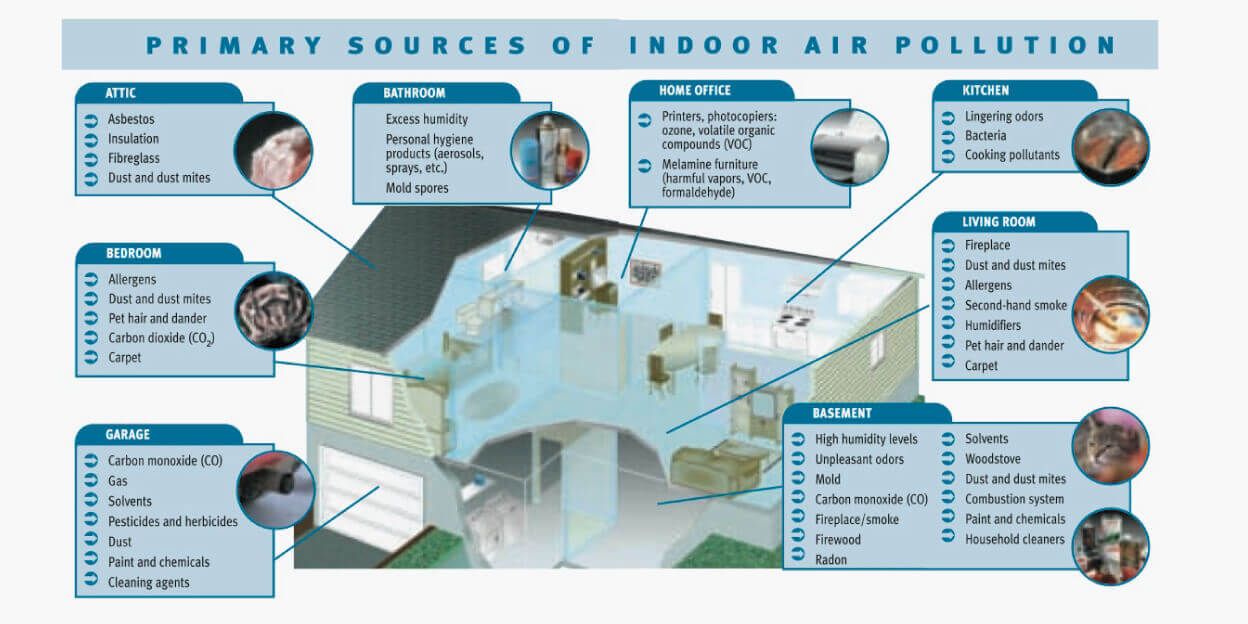Unveiling the Serious Health Impacts of Air Pollution
Air pollution, a pervasive problem affecting our planet, has far-reaching consequences for both the environment and human health. In this blog, we delve into the alarming impact of air pollution on our well-being. From respiratory illnesses to cardiovascular complications, we uncover the serious health effects that demand immediate attention and action.
Assessing health risks of indoor air pollution
Indoor exposure to air pollutants may occur in both private and public indoor environments such as homes, offices, schools, and transport systems.
Some indoor air pollutants come from the outside, but most are released inside the building, for example when cleaning or when burning fuel for cooking and heating. Furniture and construction materials can also emit pollutants. Dampness and lack of ventilation may further increase indoor air pollution.
Because indoor air can contain a mixture of many different pollutants, it is very difficult to assess the associated risks to health. Moreover, there is no such thing as a “typical indoor environment”.
This opinion considers how health risks of indoor air pollutants are currently evaluated and how they should be assessed in the future, taking into account simultaneous exposure to multiple pollutants and particularly vulnerable groups of the population such as children, pregnant women, and elderly people.
What are the main factors in indoor air quality?
- Certain chemicals from household products and home appliances are known to irritate the eyes, nose and throat. However, for many chemicals present in indoor air information is lacking on the possible health effects of long-term exposure, such as cancer or reproductive effects.
- Radon occurs naturally in parts of Europe. It can get inside buildings and may lead to lung cancer.
- Suspended particles can cause harmful effects on health, particularly on the respiratory system.
- Microbes, such as molds and viruses, can contribute to the development of asthma and allergies.
- Pets and pests such as dust mites, cockroaches, and mice, are important indoor sources of allergens.
- Low humidity causes eye irritation, dryness of the skin and the nose, and rashes, while high humidity fosters the growth of molds and dust mites.
- Insufficient ventilation, one of the most important factors in poor indoor air quality, may affect health and work performance.
- Indoor temperatures that are too high or too low are unpleasant and can be unhealthy.
How can scientists determine whether indoor air pollutants pose a health risk?
To determine whether pollutants may cause health effects, it is necessary to consider four aspects:
- Toxicity of pollutants and their concentrations in indoor air. Indoor air can for instance contain organic compounds, particles, or microbes that may cause allergies or other health effects.
- Exposure. People are mainly exposed to air pollutants when breathing but may also be exposed via other routes, such as dust ingestion. Since exposures can vary, even very low and very high exposures should be considered not only average ones.
- Exposure-response relationships. To assess the risk posed by a given pollutant, it is important to know how the body responds to different concentrations in the air. Health effects observed in people who have been exposed to pollutants at work are valuable in determining the risks posed by a particular pollutant. However, such findings may not be directly applicable to the general public.
- Risk characterization. In the final step of the risk assessment process, all the collected scientific evidence is analyzed to determine the probability that a specific pollutant will cause illness.
Are certain people more vulnerable than others to indoor air pollution?
Population groups that are potentially more vulnerable than others to indoor air pollution are children, pregnant women, elderly people, and people suffering from cardiovascular or respiratory diseases.
Depending on their age, children may be more vulnerable than adults to certain toxic substances, like lead and tobacco smoke. Even at low levels, air pollutants may disrupt the development of their lungs, cause cough, bronchitis, and other respiratory diseases, and make asthma worse.
Factors other than age and the presence of cardiovascular or respiratory diseases that may render some people more vulnerable are genetic traits, lifestyle, nutrition, and other health problems.
Why are the combined effects of indoor air pollutants hard to measure?
Like outdoor air, indoor air contains a complex mixture of pollutants (chemical substances, allergens, and microbes) from different sources that change with time.
Findings on the health effects of single air pollutants cannot necessarily be extended to mixtures. Indeed, different chemicals may interact with each other and cause more (or less) harmful effects than the sum of the effects caused by each chemical separately. Very little is known about the combined effects of indoor air pollutants.
Risk assessments that take into account the combined exposure and cumulative effects of the pollutants in indoor air are seldom possible. Nonetheless, the possibility of combined effects should be considered in the risk assessment taking a case-by-case approach.
Which chemicals found in indoor air are causing the most concern?’
Here is the list of chemicals:
- Among the combustion products that are generated by heating systems and other home appliances using gas, fuel, or wood, carbon monoxide (CO) and nitrogen dioxide (NO2) are of special concern.
- Tobacco smoke contains several types of harmful pollutants, including benzene and fine and ultrafine particles. In adults, passive smoking can cause irritation, aggravated respiratory symptoms, and coronary heart disease. In children, it can lead to sudden death syndrome and middle ear infections.
- Radon occurs naturally in certain regions. It can get inside buildings and may lead to lung cancer.
- Lead, which is still present in the paintwork of some old houses, is harmful to children even at low-level exposure.
- Organophosphate pesticides, which are often used against insects in the home, can affect the development of the nervous system and could be of concern for children.
- Volatile organic compounds (VOCs) such as benzene, formaldehyde, and naphthalene which are known to have health effects are emitted by many consumer products. VOCs may react with ground-level ozone to form secondary pollutants that can cause irritation. Altogether, the concentrations of VOCs and ozone-causing mixture effects are as yet poorly known.
Conclusion
The detrimental health effects of air pollution cannot be ignored. The evidence presented in this blog underscores the urgent need for comprehensive measures to combat air pollution and protect public health.
It is crucial for governments, organizations, and individuals to work together in adopting cleaner technologies, promoting sustainable practices, and implementing stricter regulations to mitigate air pollution.
By prioritizing clean air, we can create a healthier and safer environment for current and future generations. Let us unite in our efforts to breathe clean air and safeguard our well-being.



